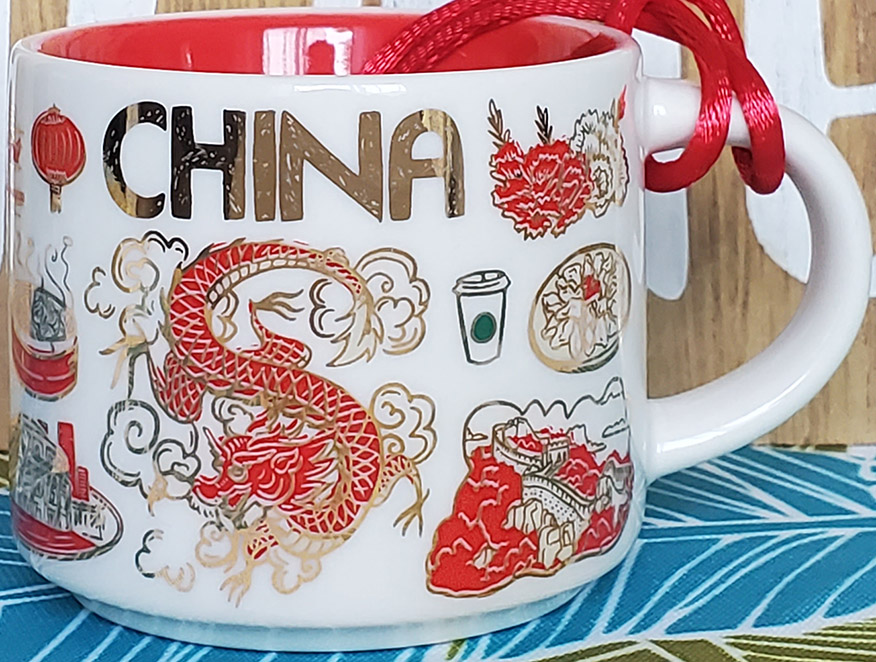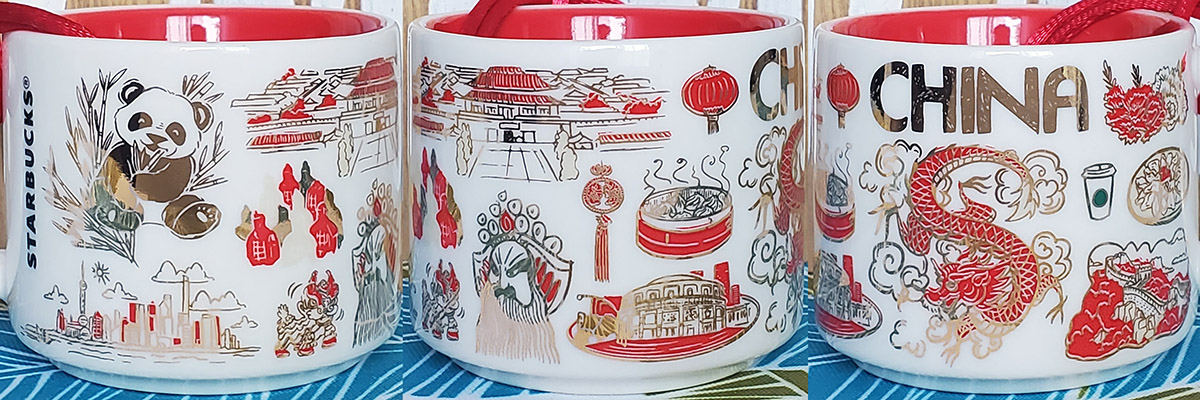
Been There Ornament – China
Been There Ornament China is hands down the best-looking ornament from this series. Similarly to the bigger mug, its design uses bold red and gold colors. As a reminder, all Been There Ornaments from Mainland China come in pairs: one country ornament and one city ornament. With that being said, if you decide to collect all the Mainland China ornaments, you are going to end up with multiples of China (country) ones.
Check this post out, where I go into more detail on different boxes for YAH and BeenThere ornaments.
Here are just a few symbols of China that you can find in the design of the Been There China Ornament:
– In Chinese culture, the dragon is a powerful symbol of strength, good luck, and authority, often associated with imperial lineage. Unlike the fearsome, fire-breathing dragons of Western lore, Chinese dragons are benevolent creatures that bring rain and prosperity, embodying wisdom and protection. Celebrations such as the Chinese New Year prominently feature dragon dances, where performers mimic the movements of this revered creature, hoping to usher in good fortune for the year ahead.
– The giant panda, native to the bamboo forests of China, is not only a national treasure but also an international symbol of wildlife conservation. With their distinctive black-and-white fur and playful demeanor, pandas have captured the hearts of people around the world, embodying peace and gentleness. They play a vital role in China’s tourism industry, drawing millions of visitors to their habitats and conservation centers, where efforts are made to protect these beloved animals and their environment.
– Lanterns are a vibrant and iconic part of Chinese festivals, particularly during the Lantern Festival, when families light and release colorful lanterns into the night sky. Traditionally, red lanterns are used to symbolize good luck and are prominently featured in decorations during celebrations like the Chinese New Year. The art of lantern-making has a rich history, with intricate designs and patterns that reflect the cultural heritage and creativity of the Chinese people, creating a festive atmosphere filled with light and hope.
– The Great Wall of China is a monumental feat of engineering, stretching over 13,000 miles and symbolizing the historical strength and perseverance of the Chinese civilization. Constructed over several dynasties, this massive structure served as a defense mechanism against invasions and raids, showcasing the strategic foresight of ancient Chinese leaders. Today, the Great Wall attracts millions of visitors annually, who come to marvel at its grandeur and explore the rich stories woven into its ancient stones.
– The Forbidden City, located in the heart of Beijing, was the imperial palace for 24 emperors of the Ming and Qing dynasties, exemplifying the zenith of Chinese architectural achievement. Enclosed by a massive wall and a moat, this palace complex remained off-limits to the general public for centuries, symbolizing imperial exclusivity and power. Today, it stands as a UNESCO World Heritage Site and a museum, offering visitors a glimpse into China’s rich history, art, and culture, while echoing the grandeur of its imperial past.
– In traditional Chinese theatre, particularly in forms like Peking Opera, masks are vital for conveying the personality and status of characters, with each color representing different traits and emotions. These intricately designed and vibrant masks are not only visually striking but also carry deep cultural significance, often linked to historical figures and folklore. Masks play an essential role in storytelling, allowing performers to transform and embody their characters, captivating audiences with the artistry of their movements and expressions.























































































If you’re wondering what the round building is on your mug, it is the Shanghai Starbucks Roastery